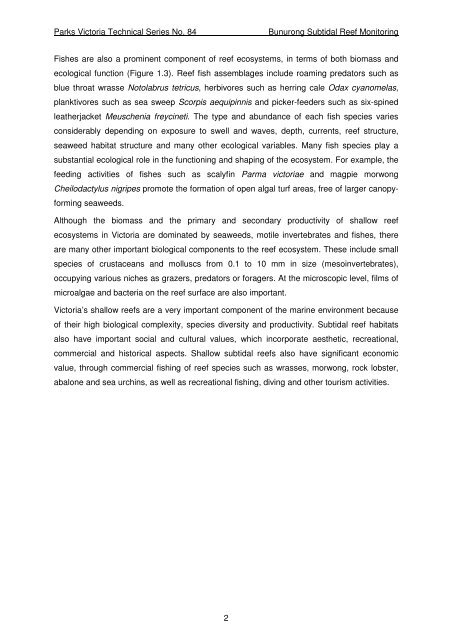the reef biota at bunurong marine national park - Parks Victoria
the reef biota at bunurong marine national park - Parks Victoria
the reef biota at bunurong marine national park - Parks Victoria
You also want an ePaper? Increase the reach of your titles
YUMPU automatically turns print PDFs into web optimized ePapers that Google loves.
<strong>Parks</strong> <strong>Victoria</strong> Technical Series No. 84<br />
Bunurong Subtidal Reef Monitoring<br />
Fishes are also a prominent component of <strong>reef</strong> ecosystems, in terms of both biomass and<br />
ecological function (Figure 1.3). Reef fish assemblages include roaming pred<strong>at</strong>ors such as<br />
blue thro<strong>at</strong> wrasse Notolabrus tetricus, herbivores such as herring cale Odax cyanomelas,<br />
planktivores such as sea sweep Scorpis aequipinnis and picker-feeders such as six-spined<br />
lea<strong>the</strong>rjacket Meuschenia freycineti. The type and abundance of each fish species varies<br />
considerably depending on exposure to swell and waves, depth, currents, <strong>reef</strong> structure,<br />
seaweed habit<strong>at</strong> structure and many o<strong>the</strong>r ecological variables. Many fish species play a<br />
substantial ecological role in <strong>the</strong> functioning and shaping of <strong>the</strong> ecosystem. For example, <strong>the</strong><br />
feeding activities of fishes such as scalyfin Parma victoriae and magpie morwong<br />
Cheilodactylus nigripes promote <strong>the</strong> form<strong>at</strong>ion of open algal turf areas, free of larger canopyforming<br />
seaweeds.<br />
Although <strong>the</strong> biomass and <strong>the</strong> primary and secondary productivity of shallow <strong>reef</strong><br />
ecosystems in <strong>Victoria</strong> are domin<strong>at</strong>ed by seaweeds, motile invertebr<strong>at</strong>es and fishes, <strong>the</strong>re<br />
are many o<strong>the</strong>r important biological components to <strong>the</strong> <strong>reef</strong> ecosystem. These include small<br />
species of crustaceans and molluscs from 0.1 to 10 mm in size (mesoinvertebr<strong>at</strong>es),<br />
occupying various niches as grazers, pred<strong>at</strong>ors or foragers. At <strong>the</strong> microscopic level, films of<br />
microalgae and bacteria on <strong>the</strong> <strong>reef</strong> surface are also important.<br />
<strong>Victoria</strong>’s shallow <strong>reef</strong>s are a very important component of <strong>the</strong> <strong>marine</strong> environment because<br />
of <strong>the</strong>ir high biological complexity, species diversity and productivity. Subtidal <strong>reef</strong> habit<strong>at</strong>s<br />
also have important social and cultural values, which incorpor<strong>at</strong>e aes<strong>the</strong>tic, recre<strong>at</strong>ional,<br />
commercial and historical aspects. Shallow subtidal <strong>reef</strong>s also have significant economic<br />
value, through commercial fishing of <strong>reef</strong> species such as wrasses, morwong, rock lobster,<br />
abalone and sea urchins, as well as recre<strong>at</strong>ional fishing, diving and o<strong>the</strong>r tourism activities.<br />
2

















